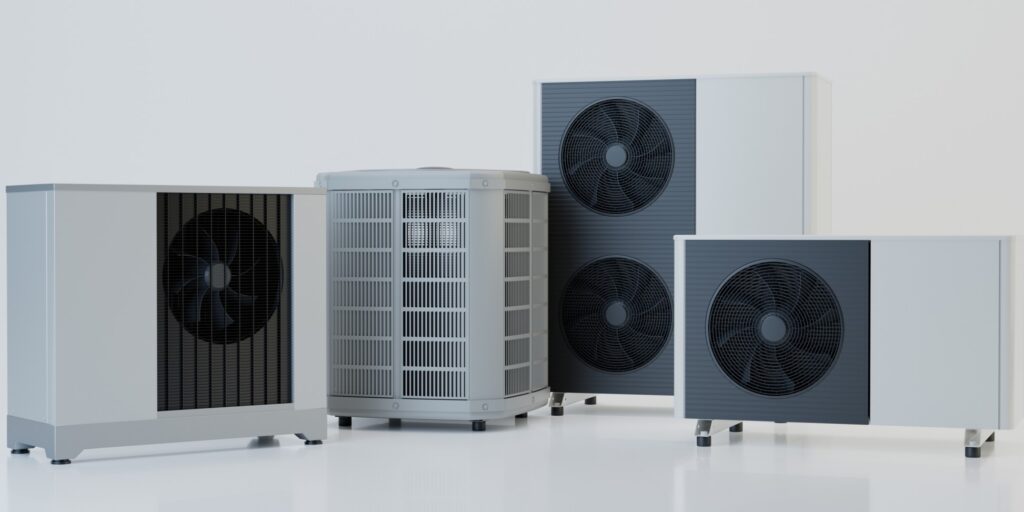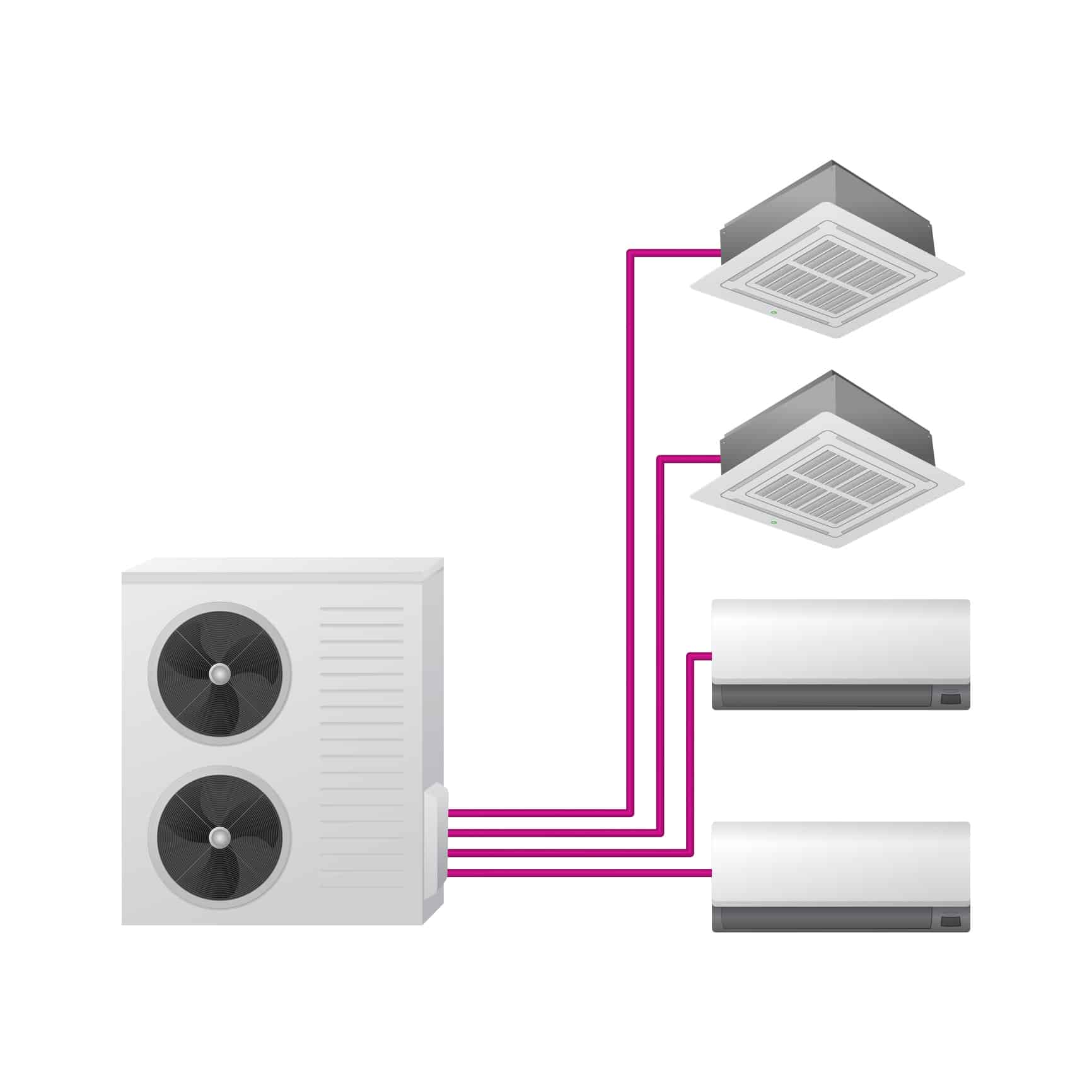
Ductless Mini-Split System vs Heat Pump
- Choosing between a ductless mini-split system and a heat pump can significantly impact your home’s comfort and energy costs.
- Ductless mini-splits offer zone-specific temperature control, easy installation, and high energy efficiency, making them ideal for homes without ductwork.
- Heat pumps are efficient in moderate climates, providing both heating and cooling, but may need supplemental heating in very cold conditions.
- Cost considerations include higher upfront costs for mini-splits but potential long-term savings, while heat pumps may have lower installation costs in ducted homes.
- Your choice should depend on your home’s specific needs and local climate.
Are you trying to choose between a ductless mini-split system and a heat pump for your home?
This decision is crucial, as it directly impacts your comfort and energy costs.
Both of these HVAC systems offer unique benefits, but they operate in different ways, making them more suitable for specific situations. Understanding the differences between ductless mini-split systems and heat pumps can help you make an informed decision that suits your home’s needs.
Choosing the right system depends on various factors. Making an informed decision can save you from future headaches and unnecessary expenses. In this article, we will explore both systems in detail, comparing their features, installation processes, and costs to help you decide which is best for your home.
What is a Ductless Mini-Split System?
A ductless mini-split system is an innovative HVAC solution that provides both heating and cooling without the need for ductwork. These systems are ideal for homes that lack existing ducts, or for those who want more control over the temperature in individual rooms.
Components of a Ductless Mini-Split System:
The system consists of two main components: an outdoor unit and one or more indoor air-handling units. The outdoor unit contains the compressor, condenser, and expansion valve, while the indoor units are responsible for circulating the air inside your home. These indoor units are typically mounted high on walls and are connected to the outdoor unit through a small conduit that houses the power cable, refrigerant tubing, suction tubing, and condensate drain.
How a Ductless Mini-Split System Works:
During the cooling process, the system works by absorbing heat from the indoor air and transferring it outside. The refrigerant in the system picks up the heat from inside your home and moves it to the outdoor unit, where it is released into the atmosphere. This process effectively cools the indoor space.
In heating mode, the process is reversed. The outdoor unit absorbs heat from the air outside—even in colder temperatures—and transfers it indoors. The ability to reverse the refrigeration cycle is what allows a mini-split system to provide both heating and cooling.
Ductless mini-splits offer several advantages, including energy efficiency, easy installation, and the ability to control the temperature in individual rooms, making them an excellent choice for many homeowners.
What is a Heat Pump?
A heat pump is a versatile HVAC system that can both heat and cool your home by transferring heat between the inside and outside air. This technology makes heat pumps an efficient solution for maintaining a comfortable indoor environment year-round.
Components of a Heat Pump:
A typical heat pump system includes an outdoor unit and an indoor air handler. The outdoor unit houses the compressor and a fan, while the indoor unit contains the evaporator coil and a fan to distribute air throughout your home. The system also includes a reversing valve, which allows it to switch between heating and cooling modes, depending on the season.
How a Heat Pump Works:
In cooling mode, a heat pump operates similarly to an air conditioner. It extracts heat from the indoor air and releases it outside. The refrigerant in the system absorbs the indoor heat and transports it to the outdoor unit, where the heat is expelled, leaving the indoor air cooler.
In heating mode, the process is reversed. The heat pump extracts heat from the outdoor air—even in cold weather—and brings it inside to warm your home. The system leverages the refrigerant to absorb heat from the outdoor air, which is then compressed to a higher temperature and released indoors.
One of the significant benefits of heat pumps is their energy efficiency. Instead of generating heat by burning fuel, they move existing heat, which can result in lower energy consumption compared to traditional heating methods. However, their efficiency can decrease in extremely cold climates, making them more suitable for moderate climates.
Heat pumps are an all-in-one solution for homeowners seeking both heating and cooling capabilities with lower environmental impact and operational costs.

Energy Efficiency: Ductless Mini-Split vs. Heat Pump
When it comes to energy efficiency, both ductless mini-split systems and heat pumps are designed to minimize energy consumption while maximizing comfort. However, the way they achieve this efficiency differs, and the best option for your home will depend on your specific needs and climate.
Energy Consumption Comparison:
Ductless mini-split systems are known for their exceptional energy efficiency, largely because they eliminate the energy losses associated with ductwork. In a traditional HVAC system, ducts can lose up to 30% of energy due to leaks, poor insulation, and other factors. Ductless systems avoid this by delivering air directly to individual rooms, ensuring that more of the energy is used for heating or cooling.
Heat pumps are also highly efficient, particularly in moderate climates. They use electricity to transfer heat rather than generate it, which can be significantly more energy-efficient than traditional heating methods, such as furnaces. However, in extremely cold climates, heat pumps may require additional energy to maintain comfort levels, which can reduce their overall efficiency.
Inverter Technology and Its Impact on Efficiency:
Both ductless mini-split systems and many modern heat pumps use inverter technology to enhance energy efficiency. Inverter technology allows the compressor to adjust its speed based on the heating or cooling demand, rather than running at full capacity all the time. This not only saves energy but also reduces wear and tear on the system, leading to a longer lifespan.
Inverter-driven systems maintain a more consistent indoor temperature, avoiding the frequent on-off cycling that can occur with traditional systems. This not only improves comfort but also results in lower energy bills over time.
Overall, while both systems are energy-efficient, the ductless mini-split system has the edge in scenarios where duct losses are a concern or when precise temperature control in individual rooms is desired. Heat pumps, however, offer a more comprehensive solution for whole-home heating and cooling, particularly in regions with moderate climates.
Installation Process: Mini-Split vs. Heat Pump
The installation process for both ductless mini-split systems and heat pumps involves several key steps, but they differ significantly in complexity and requirements. Understanding these differences can help you determine which system is better suited to your home’s needs.
Installation Requirements for Each System:
Ductless mini-split systems are known for their relatively simple installation process. Since they don’t require ductwork, they are an excellent option for homes without existing ducts or for adding climate control to specific areas, such as additions or renovated spaces.
The installation involves mounting the indoor air-handling units on walls, usually near the ceiling, and connecting them to the outdoor unit through a small hole in the wall for the conduit. This conduit contains the power cable, refrigerant tubing, suction tubing, and condensate drain line.
Heat pumps, particularly those that are part of a central HVAC system, typically require more extensive installation work. If your home already has ductwork in place, a heat pump can often be integrated into the existing system, replacing or complementing your current heating and cooling systems.
However, if ducts need to be installed or upgraded, the process can become more complex and costly. Installing a heat pump involves placing the outdoor unit, connecting it to the indoor air handler or handlers, and ensuring the ductwork is properly sealed and insulated to prevent energy loss.
Ease of Installation and Retrofitting:
Mini-split systems offer greater flexibility and ease of installation, especially in older homes or buildings where adding ductwork would be difficult or disruptive. These systems are often installed within a day or two, causing minimal disruption to your home. Additionally, since they operate independently, mini-splits are easy to retrofit in existing homes without extensive renovations.
Heat pumps may require more time and effort to install, particularly if ductwork needs to be added or modified. This process can be more invasive and may take several days to complete, depending on the complexity of the job. However, once installed, heat pumps offer comprehensive heating and cooling throughout your home, which can make the upfront effort worthwhile for many homeowners.
Overall, if you’re looking for a quicker, less invasive installation, a ductless mini-split system may be the better choice. However, if you’re aiming to replace an existing central HVAC system and want whole-home coverage, a heat pump might be the more appropriate option.
Cost Considerations
When choosing between a ductless mini-split system and a heat pump, understanding the cost implications is essential. Both the initial installation costs and long-term operational expenses can vary significantly, depending on your choice.
Initial Installation Costs:
Ductless mini-split systems generally have a higher upfront cost compared to traditional HVAC systems. The cost varies based on the number of indoor units required, with each unit typically controlling the temperature in a single room or zone. For homes requiring multiple zones, the cost can increase accordingly. However, the installation process is less invasive and quicker, which can save on labor costs.
Heat pumps, particularly when integrated into an existing ducted system, often have a lower initial installation cost compared to ductless mini-splits. The typical installation cost for a heat depends on the size of the system and whether any modifications to existing ductwork are necessary. If ducts need to be installed or upgraded, this can add to the overall cost. However, for homes with existing ductwork, a heat pump might be more cost-effective in terms of installation.
Long-Term Operational Costs and Potential Savings:
When considering long-term costs, ductless mini-splits often provide significant savings due to their energy efficiency and zone-specific temperature control. By only heating or cooling the rooms in use, homeowners can reduce their energy bills. Additionally, because there is no ductwork, energy losses that typically occur in traditional HVAC systems are eliminated. Over time, these savings can offset the higher initial installation cost.
Heat pumps are also known for their energy efficiency, especially in moderate climates. They offer a balance between upfront cost and long-term savings, with the potential to reduce heating and cooling costs by 30% to 50% compared to traditional systems. However, in colder climates, the efficiency of a heat pump may decrease, leading to higher energy use during winter months, which could impact operational costs.
Overall, while both systems have their costs and benefits, your decision should be guided by your home’s specific needs, the local climate, and your long-term budget considerations.

Zoning Capabilities
Zoning capabilities are a key factor when choosing between a ductless mini-split system and a heat pump, as they directly impact your ability to control the temperature in different areas of your home. Both systems offer zoning options, but they do so in different ways, which can influence your decision based on your specific needs.
How Mini-Split Systems Enable Zone-Specific Control:
Ductless mini-split systems excel in providing precise, zone-specific control. Each indoor unit operates independently, allowing you to set different temperatures for different rooms or zones in your home. For instance, you can keep your living room cooler while maintaining a warmer temperature in the bedrooms. This level of control not only enhances comfort but also improves energy efficiency, as you only heat or cool the spaces that are in use.
This zoned approach is particularly beneficial in homes with varied heating and cooling needs across different rooms or levels. For example, if you have a home office that needs to be kept cool during the day but bedrooms that only need heating at night, a mini-split system allows you to meet these specific needs without wasting energy on unused areas.
Comparison with Heat Pump Zoning Capabilities:
Heat pumps, when integrated with a central ducted system, can also offer zoning capabilities, but they typically require additional components like dampers and zone control panels. These systems divide your home into different zones, each controlled by a separate thermostat. The dampers within the ductwork open or close to regulate airflow to each zone, allowing you to manage temperatures in different areas of your home.
While effective, this method is less precise than the individual control provided by ductless mini-splits, as it still relies on a central system to distribute air throughout the home. Additionally, setting up a zoned heat pump system can be more complex and expensive, particularly if your home’s existing ductwork is not optimized for zoning.
Which System Offers Better Zoning?
If your priority is maximizing control over individual rooms and ensuring that each space is perfectly tuned to your desired temperature, a ductless mini-split system is likely the better choice. The ability to adjust each indoor unit independently allows for unparalleled flexibility and efficiency.
On the other hand, if you’re looking to maintain consistent temperatures across larger zones, and your home already has ductwork in place, a heat pump with zoning capabilities might be sufficient. This option can still provide energy savings and comfort, particularly if your heating and cooling needs are not highly variable from room to room.
The superior zoning capabilities of ductless mini-splits make them an attractive option for homeowners who value precise temperature control in individual areas of their home, while heat pumps with zoning capabilities are better suited for more uniform temperature management across broader areas.
FAQs
-
What are the main differences between ductless mini-splits and heat pumps?
Ductless mini-splits are ideal for homes without existing ductwork, offering zone-specific control and easy installation. They are particularly energy-efficient because they avoid the energy losses associated with ducts. Heat pumps, on the other hand, work well with existing duct systems and can efficiently heat and cool an entire home. They are best suited for moderate climates and may require additional heating support in icy weather.
-
Which system is more cost-effective in the long run?
Both systems can offer long-term savings, depending on your home and climate. Ductless mini-splits often result in lower energy bills due to their zone-specific control and lack of ductwork, making them highly efficient. Heat pumps provide cost-effective heating and cooling in moderate climates but may have higher operational costs in extremely cold regions if supplemental heating is needed.
-
Can I install a ductless mini-split system myself?
While it’s technically possible to install a ductless mini-split system yourself, it’s not recommended unless you have HVAC experience. Proper installation requires precise handling of refrigerants, electrical work, and mounting. Improper installation can lead to reduced efficiency, potential damage, and voided warranties. It’s best to hire a professional to ensure optimal performance and safety.
-
What maintenance does each system require?
Both systems require regular maintenance to operate efficiently. For ductless mini-splits, you should clean or replace the filters every month or two, keep the outdoor unit clear of debris, and have a professional inspect the system annually. Heat pumps require similar maintenance, including filter changes, cleaning the outdoor unit, and checking the system’s refrigerant levels. Regular professional inspections are recommended for both systems.
-
Which system is better for extreme climates?
For extremely cold climates, a heat pump with supplemental heating may be necessary, but it might not be as efficient as other heating options. Ductless mini-splits perform well in a range of conditions but may struggle in very cold weather without additional heating sources. In extremely hot climates, both systems can efficiently cool your home, but ductless mini-splits offer more precise zone control, which can be beneficial.


